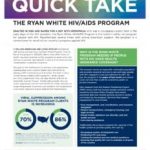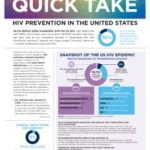Today the O’Neill Institute released two new Quick Take documents. Following the November 2018 election, with many new members of Congress, these reports are intended as educational resources for legislators and congressional staff as well as for HIV community stakeholders and the general public. Building upon a March 2017 issue brief on the Ryan White HIV/AIDS Program and a March 2018 issue brief on HIV prevention, the new documents provide updated data condensed in a two-page infographic format. The Quick Take documents are products of an HIV Policy Project at the O’Neill Institute and were developed with financial support from Gilead Sciences.
 The first document, Quick Take: The Ryan White HIV/AIDS Program, is focused on the nation’s safety net program for people with HIV. Enacted in 1990 and named for a boy with hemophilia who was the courageous face in the early days of the HIV epidemic, the Ryan White Program is a cornerstone for the progress against HIV in the United States. Of the 1.1 million Americans living with HIV, almost half receive services from the Ryan White Program, and the program is making a difference. Viral suppression among Ryan White Program clients is increasing, from 70% of clients virally suppressed in 2010 to 86% of clients virally suppressed in 2017. Data from the Centers for Disease Control and Prevention (CDC) also shows that low-income people served in centers funded by the Ryan White Program have better health outcomes than low-income persons served in centers not funded by the program. Services that support engagement in care and better health outcomes include: (1) case management, care coordination, and insurance navigation, (2) medical transportation, emergency housing, and legal services, (3) mental health, substance use disorder, and oral health services, and (4) cost-sharing assistance. Additionally, the program expands the capacity of the health system to provide quality HIV care by developing models of integrated care, monitoring HIV outcomes, training the medical and non-medical workforce, and ensuring the quality of HIV care is available in all parts of the country.
The first document, Quick Take: The Ryan White HIV/AIDS Program, is focused on the nation’s safety net program for people with HIV. Enacted in 1990 and named for a boy with hemophilia who was the courageous face in the early days of the HIV epidemic, the Ryan White Program is a cornerstone for the progress against HIV in the United States. Of the 1.1 million Americans living with HIV, almost half receive services from the Ryan White Program, and the program is making a difference. Viral suppression among Ryan White Program clients is increasing, from 70% of clients virally suppressed in 2010 to 86% of clients virally suppressed in 2017. Data from the Centers for Disease Control and Prevention (CDC) also shows that low-income people served in centers funded by the Ryan White Program have better health outcomes than low-income persons served in centers not funded by the program. Services that support engagement in care and better health outcomes include: (1) case management, care coordination, and insurance navigation, (2) medical transportation, emergency housing, and legal services, (3) mental health, substance use disorder, and oral health services, and (4) cost-sharing assistance. Additionally, the program expands the capacity of the health system to provide quality HIV care by developing models of integrated care, monitoring HIV outcomes, training the medical and non-medical workforce, and ensuring the quality of HIV care is available in all parts of the country.
The Quick Take document on the Ryan White Program discusses how the program is leading the way in getting people with HIV virally suppressed and reducing disparities in HIV health outcomes. The documents describes the parts of the Ryan White Program and the importance of the program for meeting the health care needs of people with HIV and addressing new challenges, such as responding to an aging population of people with HIV and meeting the needs of people with HIV who use drugs in the context of the current opioid crisis.
 The second document, Quick Take: HIV Prevention in the United States, provides an overview of the HIV epidemic in the United States. Gay and bisexual men, especially Black and Latinx gay and bisexual men, are disproportionately impacted by HIV, and transgender people are also at high risk for HIV infection. Out of more than 3,000 counties in the United States, half of new HIV diagnoses occur in only 46 counties, and half of new HIV diagnoses in the United States occur in the South, even though only 38% of Americans live in the South. Notably, inadequate services for people who inject drugs may threaten our progress on HIV prevention. CDC modeling indicates that 220 counties are at great risk of an HIV or Hepatitis C outbreak associated with injection drug use.
The second document, Quick Take: HIV Prevention in the United States, provides an overview of the HIV epidemic in the United States. Gay and bisexual men, especially Black and Latinx gay and bisexual men, are disproportionately impacted by HIV, and transgender people are also at high risk for HIV infection. Out of more than 3,000 counties in the United States, half of new HIV diagnoses occur in only 46 counties, and half of new HIV diagnoses in the United States occur in the South, even though only 38% of Americans live in the South. Notably, inadequate services for people who inject drugs may threaten our progress on HIV prevention. CDC modeling indicates that 220 counties are at great risk of an HIV or Hepatitis C outbreak associated with injection drug use.
The Quick Take on HIV prevention describes the range of tools and approaches used to prevent HIV infection and discusses the need for new investment in HIV prevention. Effective HIV prevention includes providing access to condoms, HIV testing and linkage to care, treatment as prevention, pre-exposure prophylaxis (PrEP) and post-exposure prophylaxis (PEP), and syringe and harm reduction services.
Ensuring that all people with HIV can maintain their health and viral suppression and preventing new HIV infections are hard, but we are seeing success from the Ryan White Program and HIV prevention efforts. Continued support for the Ryan White Program and HIV prevention will help us end the HIV epidemic. To read the Quick Take documents and learn more about the Infectious Diseases Initiative at the O’Neill Institute, please check out our webpage.



